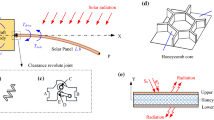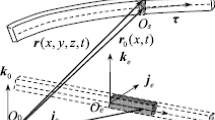Abstract
A geometric nonlinear modeling approach for strong rigid–flexible–thermal coupling dynamics of a hub and multiplate system considering frictional contact is proposed. Based on the absolute nodal coordinate formulation (ANCF), an ANCF thin-plate element with thermoelasticity is developed, where the temperature field is expressed with Taylor polynomials to yield heat-conduction equations. In contrast to the traditional coupling formulations, the influences of the attitude motion and structural deformation on the intensity of the solar radiation, the geometric nonlinearity of the plate as well as the frictional contact are taken into account. The frictional-contact formulations for a thin plate and a rigid body are presented, which can capture the stick–slip transition and address the multiple-point contact scenarios. To solve the strong rigid–flexible–thermal coupling equations, a novel numerical approach combining the generalized-\(\alpha \) method and the modified central-difference method is proposed. Two validations are performed to verify the proposed model, which proves the importance of considering the geometric nonlinearity and reveals the phenomena of thermally induced vibrations. Then, the thermal–dynamic coupling analysis for the satellite and solar-array multibody system in a thermal environment is carried out. The dynamic characteristics of the thermally induced vibration can be successfully revealed by the rigid–flexible–thermal coupling model. Furthermore, it is indicated that the influence of contact and thermal load on the nonlinear behavior of the solar-array deployment is essential, which demonstrates the feasibility of the proposed approach.




























Similar content being viewed by others
References
Thornton, E.A., Kim, Y.A.: Thermally induced bending vibrations of a flexible rolled-up solar array. J. Spacecr. Rockets 30(4), 438–448 (1993)
Johnston, J.D., Thornton, E.A.: Thermally induced attitude dynamics of a spacecraft with a flexible appendage. J. Guid. Control Dyn. 21(4), 581–587 (1998)
Johnston, J.D., Thornton, E.A.: Thermally induced dynamics of satellite solar panels. J. Spacecr. Rockets 37(5), 604–613 (2000)
Fan, W., Liu, J.: Geometric nonlinear formulation for thermal-rigid-flexible coupling system. Acta Mech. Sin. 29(5), 728–737 (2013)
Shen, Z., Tian, Q., Liu, X., Hu, G.: Thermally induced vibrations of flexible beams using absolute nodal coordinate formulation. Aerosp. Sci. Technol. 29(1), 386–393 (2013)
Shen, Z., Hu, G.: Thermally induced dynamics of a spinning spacecraft with an axial flexible boom. J. Spacecr. Rockets 52, 1503–1508 (2015)
Shen, Z., Hu, G.: Thermoelastic–structural analysis of space thin-walled beam under solar flux. AIAA J. 57(4), 1781–1785 (2019)
Čepon, G., Starc, B., Zupančič, B., Boltežar, M.: Coupled thermo-structural analysis of a bimetallic strip using the absolute nodal coordinate formulation. Multibody Syst. Dyn. 41(4), 391–402 (2017)
Liu, L., Sun, S., Cao, D., Liu, X.: Thermal-structural analysis for flexible spacecraft with single or double solar panels: a comparison study. Acta Astronaut. 154, 33–43 (2019)
Liu, L., Cao, D., Huang, H., Shao, C., Xu, Y.: Thermal-structural analysis for an attitude maneuvering flexible spacecraft under solar radiation. Int. J. Mech. Sci. 126, 161–170 (2017)
Liu, L., Wang, X., Sun, S., Cao, D., Liu, X.: Dynamic characteristics of flexible spacecraft with double solar panels subjected to solar radiation. Int. J. Mech. Sci. 151, 22–32 (2019)
Li, Y., Wang, C., Huang, W.: Rigid–flexible–thermal analysis of planar composite solar array with clearance joint considering torsional spring, latch mechanism and attitude controller. Nonlinear Dyn. 96(3), 2031–2053 (2019)
Liu, J., Pan, K.: Rigid–flexible–thermal coupling dynamic formulation for satellite and plate multibody system. Aerosp. Sci. Technol. 52, 102–114 (2016)
Shabana, A.A.: Flexible multibody dynamics: review of past and recent developments. Multibody Syst. Dyn. 1(2), 189–222 (1997)
Dmitrochenko, O.N., Pogorelov, D.Y.: Generalization of plate finite elements for absolute nodal coordinate formulation. Multibody Syst. Dyn. 10(1), 17–43 (2003)
Dmitrochenko, O., Mikkola, A.: Two simple triangular plate elements based on the absolute nodal coordinate formulation. J. Comput. Nonlinear Dyn. 3(4), 041012 (2008)
Dufva, K., Shabana, A.A.: Analysis of thin plate structures using the absolute nodal coordinate formulation. Proc. Inst. Mech. Eng., Part K, J. Multi-Body Dyn. 219(4), 345–355 (2005)
Ren, H.: Fast and robust full-quadrature triangular elements for thin plates/shells with large deformations and large rotations. J. Comput. Nonlinear Dyn. 10(5), 051018 (2015)
Schwab, A.L., Gerstmayr, J., Meijaard, J.P.: Comparison of three-dimensional flexible thin plate elements for multibody dynamic analysis: finite element formulation and absolute nodal coordinate formulation. In: ASME 2007 International Design Engineering Technical Conferences and Computers and Information in Engineering Conference, Las Vegas, Nevada, USA (2007)
Vaziri Sereshk, M., Salimi, M.: Comparison of finite element method based on nodal displacement and absolute nodal coordinate formulation (ANCF) in thin shell analysis. Int. J. Numer. Methods Biomed. Eng. 27(8), 1185–1198 (2011)
Hyldahl, P., Mikkola, A.M., Balling, O., Sopanen, J.T.: Behavior of thin rectangular ANCF shell elements in various mesh configurations. Nonlinear Dyn. 78(2), 1277–1291 (2014)
Liu, C., Tian, Q., Hu, H.: New spatial curved beam and cylindrical shell elements of gradient-deficient absolute nodal coordinate formulation. Nonlinear Dyn. 70(3), 1903–1918 (2012)
Gerstmayr, J., Sugiyama, H., Mikkola, A.: Review on the absolute nodal coordinate formulation for large deformation analysis of multibody systems. J. Comput. Nonlinear Dyn. 8(3), 031016 (2013)
Liu, C., Tian, Q., Yan, D., Hu, H.: Dynamic analysis of membrane systems undergoing overall motions, large deformations and wrinkles via thin shell elements of ANCF. Comput. Methods Appl. Mech. Eng. 258, 81–95 (2013)
Shen, Z., Hu, G.: Thermally induced vibrations of solar panel and their coupling with satellite. Int. J. Appl. Mech. 5, 1350031 (2013)
Cui, Y., Yu, Z., Lan, P.: A novel method of thermo-mechanical coupled analysis based on the unified description. Mech. Mach. Theory 134, 376–392 (2019)
Cui, Y., Lan, P., Zhou, H., Yu, Z.: The rigid–flexible–thermal coupled analysis for spacecraft carrying large-aperture paraboloid antenna. J. Comput. Nonlinear Dyn. 15(3), 031003 (2020)
Wriggers, P.: Computational Contact Mechanics. Springer, Berlin (2006)
Konyukhov, A., Izi, R.: Introduction to Computational Contact Mechanics: A Geometrical Approach. Wiley, Chichester (2015)
Flores, P.: Contact mechanics for dynamical systems: a comprehensive review. Multibody Syst. Dyn. 54(2), 127–177 (2022)
Flores, P.: Contact mechanics for dynamical systems: a comprehensive review. Multibody Syst. Dyn. 54(2), 127–177 (2022). https://doi.org/10.1007/s11044-021-09803-y
Konyukhov, A., Schweizerhof, K.: Computational Contact Mechanics: Geometrically Exact Theory for Arbitrary Shaped Bodies. Springer, Berlin (2013)
Schweizerhof, K., Konyukhov, A.: Covariant description for frictional contact problems. Comput. Mech. 35, 190–213 (2005)
Yu, L., Zhao, Z., Tang, J., Ren, G.: Integration of absolute nodal elements into multibody system. Nonlinear Dyn. 62(4), 931–943 (2010)
Shi, J., Liu, Z., Hong, J.: Dynamic contact model of shell for multibody system applications. Multibody Syst. Dyn. 44(4), 335–366 (2018)
Sun, D., Liu, C., Hu, H.: Dynamic computation of 2D segment-to-segment frictionless contact for a flexible multibody system subject to large deformation. Mech. Mach. Theory 140, 350–376 (2019)
Sun, D., Liu, C., Hu, H.: Dynamic computation of 2D segment-to-segment frictional contact for a flexible multibody system subject to large deformations. Mech. Mach. Theory 158, 104197 (2021)
Gay Neto, A., Wriggers, P.: Master-master frictional contact and applications for beam-shell interaction. Comput. Mech. 66(6), 1213–1235 (2020)
Tang, L., Liu, J.: Frictional contact analysis of sliding joints with clearances between flexible beams and rigid holes in flexible multibody systems. Multibody Syst. Dyn. 49(2), 155–179 (2019)
Lei, B., Ma, Z., Liu, J., Liu, C.: Dynamic modelling and analysis for a flexible brush sampling mechanism. Multibody Syst. Dyn. 56(4), 335–365 (2022)
Yuan, T., Liu, Z., Zhou, Y., Liu, J.: Dynamic modeling for foldable origami space membrane structure with contact-impact during deployment. Multibody Syst. Dyn. 50(1), 1–24 (2020)
Yuan, T., Tang, L., Liu, Z., Liu, J.: Nonlinear dynamic formulation for flexible origami-based deployable structures considering self-contact and friction. Nonlinear Dyn. 106(3), 1789–1822 (2021)
Boley, B., Weiner, J.: Theory of Thermal Stresses. Dover Civil and Mechanical Engineering Series. Dover, New York (1960)
Hetnarski, R.B.M.: Thermal Stresses – Advanced Theory and Applications. Solid Mechanics and Its Applications. Springer, Dordrecht (2008)
Eslami, M., Hetnarski, R., Ignaczak, J., Noda, N., Sumi, N., Tanigawa, Y.: Theory of Elasticity and Thermal Stresses: Explanations, Problems and Solutions. Springer, Dordrecht (2013)
Liu, J., Lu, H.: Thermal effect on the deformation of a flexible beam with large kinematical driven overall motions. Eur. J. Mech. A, Solids 26(1), 137–151 (2007)
Yuan, T., Tang, L., Liu, J.: Dynamic modeling and analysis for inflatable mechanisms considering adhesion and rolling frictional contact. Mech. Mach. Theory 184, 105295 (2023)
Tang, L., Liu, J.: Modeling and analysis of sliding joints with clearances in flexible multibody systems. Nonlinear Dyn. 94(4), 2423–2440 (2018)
Wang, X.: Finite Element Method. Tsinghua University Press, Beijing (2003)
Haug, E.J.: Computer Aided Kinematics and Dynamics of Mechanical Systems. Allyn & Bacon, Boston (1989)
Hong, J.: Computational Dynamics of Multibody Systems. Higher Education Press, Beijing (1999)
Liu, Z., Liu, J.: Experimental validation of rigid-flexible coupling dynamic formulation for hub–beam system. Multibody Syst. Dyn. 40(3), 303–326 (2017)
Arnold, M., Brüls, O.: Convergence of the generalized-\(\alpha \) scheme for constrained mechanical systems. Multibody Syst. Dyn. 18(2), 185–202 (2007)
Köbis, M., Arnold, M.: Convergence of generalized-\(\boldsymbol{\alpha}\) time integration for nonlinear systems with stiff potential forces. Multibody Syst. Dyn. 37(1), 107–125 (2016)
Noels, L., Stainier, L., Ponthot, J.P.: Self-adapting time integration management in crash-worthiness and sheet metal forming computations. Int. J. Veh. Des. 30(1–2), 67–114 (2002)
Funding
This research was supported by the General Program (No. 12272221) of the National Natural Science Foundation of China , the Key Program (No. 11932001) of the National Natural Science Foundation of China, and the International (Regional) Cooperation and Exchange Programs (No. 12311530038) of the National Natural Science Foundation of China, for which the authors are grateful. This research was also supported by the Key Laboratory of Hydrodynamics (Ministry of Education).
Author information
Authors and Affiliations
Contributions
Tingting Yuan proposed the conceptualization and methodology of this study, and performed simulation and analysis, and wrote the main manuscript text. Bo Lei performed the valication and the data analysis. Jinyang Liu helped perform the formulations and analysis with constructive discussion. Yunli Wu helped perform simulation. All authors reviewed the manuscript.
Corresponding author
Ethics declarations
Competing interests
The authors declare no competing interests.
Additional information
Publisher’s Note
Springer Nature remains neutral with regard to jurisdictional claims in published maps and institutional affiliations.
Appendix. Solution scheme for the rigid–flexible–thermal coupling equations
Appendix. Solution scheme for the rigid–flexible–thermal coupling equations
The solution scheme for the rigid–flexible–thermal coupling equations is divided into the following three steps:
-
Step1: Prediction of the initial value
Assuming that \(\ddot{\mathbf{q}}_{d}^{t + \Delta t} = \mathbf{0}\), we combine Taylor’s formula, the generalized-\(\alpha \) method, and a modified central-difference method to predict \(\mathbf{a}_{d}^{t + \Delta t}\), \(\mathbf{q}_{d}^{t + \Delta t}\), \(\dot{\mathbf{q}}_{d}^{t + \Delta t}\), \(\boldsymbol{\lambda}^{t + \Delta t}\), \(\mathbf{p}^{t + \Delta t}\), as follows:
where
and the numerical parameters \(\rho _{\infty}, \theta \in [0, 1]\). The numerical parameters in this paper are taken as \(\rho _{\infty} = 0.6\), \(\theta = 0.5\).
-
Step2: Transformation into nonlinear algebraic equations
The dynamic equations can be transformed into nonlinear algebraic equations using the generalized-\(\alpha \) method [53]
where
The heat-conduction equations in Eq. (48) are transformed into nonlinear algebraic equations by a modified central-difference method [49]
where
-
Step3: Solution of the combined nonlinear algebraic equations
According to Eqs. (A8) and (A11), the combined nonlinear algebraic equations are rewritten as
The Newton–Raphson algorithm is used to find a solution of Eq. (A14). At an iteration step \(k\), the following equation is solved for a correction \(\Delta \mathbf{q}_{(k)}^{t + \Delta t}\):
where
An improved estimate can be obtained as
until the precision condition \(\left \| \Delta \mathbf{q}_{(k)}^{t + \Delta t} \right \| \le \delta \) is satisfied, in which \(\delta \) is the precision error.
Rights and permissions
Springer Nature or its licensor (e.g. a society or other partner) holds exclusive rights to this article under a publishing agreement with the author(s) or other rightsholder(s); author self-archiving of the accepted manuscript version of this article is solely governed by the terms of such publishing agreement and applicable law.
About this article
Cite this article
Yuan, T., Lei, B., Liu, J. et al. Rigid–flexible–thermal coupling dynamics of a hub and multiplate system considering frictional contact. Multibody Syst Dyn 59, 363–394 (2023). https://doi.org/10.1007/s11044-023-09925-5
Received:
Accepted:
Published:
Issue Date:
DOI: https://doi.org/10.1007/s11044-023-09925-5




